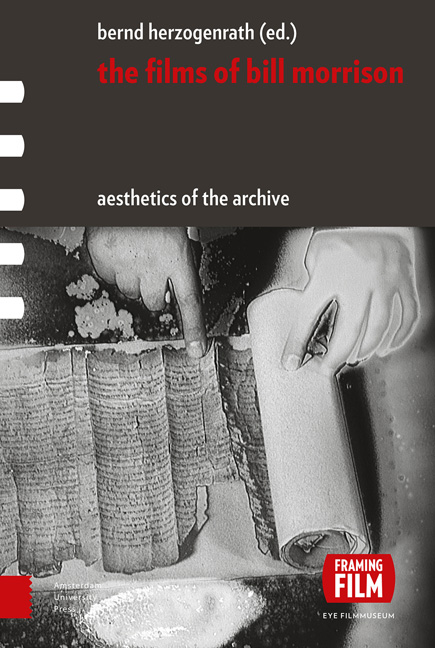Book contents
- Frontmatter
- Contents
- Acknowledgments
- Aesthetics of the Archive: An Introduction
- Chapter 1 Drafts and Fragments: Reflections around Bill Morrison and the Paper Print Collection
- Chapter 2 The Film of Her: The Cine-Poet Laureate of Orphan Films
- Chapter 3 Ghost Trip: Searching for Potential Myths
- Chapter 4 Decasia: The Matter | Image: Film is also a Thing
- Chapter 5 The Mesmerist: Illustrating the Return of the Repressed
- Chapter 6 Light is Calling: Celluloid Dreams
- Chapter 7 Gotham: Zoetrope: Block by Block
- Chapter 8 Outerborough: Early Cinema Revisited
- Chapter 9 The Highwater Trilogy: Thinking the Liquid – On the Ethics of Water and the Material Ecologies of Disaster and Ruination
- Chapter 10 Porch: Archives, Collective Memory, and the Poetics of Home Movies
- Chapter 11 The Future Lasts Long: The Romanov Lost Family Archives
- Chapter 12 Who by Water: Variations on Matter, Figures, Memory, and Mythology
- Chapter 13 Every Stop on the F-Train: Beyond and within the Restless Netherworld of (Manhattan’s) Mind
- Chapter 14 Spark of Being: Bachelor Machine
- Chapter 15 The Miners’ Hymns: Acts of Resurrection
- Chapter 16 Tributes – Pulse: A Requiem for the 20th Century: Death | Drive | Image
- Chapter 17 Just Ancient Loops: The Loops of Life in Intonation
- Chapter 18 The Great Flood: Water is Transparence Derived from the Presence of Everything
- Chapter 19 Re-Awakenings: Bill Morrison in Conversation
- Index of Film Titles
- Index of Names
- Index of Subjects
- Already Published
Chapter 12 - Who by Water: Variations on Matter, Figures, Memory, and Mythology
Published online by Cambridge University Press: 12 December 2020
- Frontmatter
- Contents
- Acknowledgments
- Aesthetics of the Archive: An Introduction
- Chapter 1 Drafts and Fragments: Reflections around Bill Morrison and the Paper Print Collection
- Chapter 2 The Film of Her: The Cine-Poet Laureate of Orphan Films
- Chapter 3 Ghost Trip: Searching for Potential Myths
- Chapter 4 Decasia: The Matter | Image: Film is also a Thing
- Chapter 5 The Mesmerist: Illustrating the Return of the Repressed
- Chapter 6 Light is Calling: Celluloid Dreams
- Chapter 7 Gotham: Zoetrope: Block by Block
- Chapter 8 Outerborough: Early Cinema Revisited
- Chapter 9 The Highwater Trilogy: Thinking the Liquid – On the Ethics of Water and the Material Ecologies of Disaster and Ruination
- Chapter 10 Porch: Archives, Collective Memory, and the Poetics of Home Movies
- Chapter 11 The Future Lasts Long: The Romanov Lost Family Archives
- Chapter 12 Who by Water: Variations on Matter, Figures, Memory, and Mythology
- Chapter 13 Every Stop on the F-Train: Beyond and within the Restless Netherworld of (Manhattan’s) Mind
- Chapter 14 Spark of Being: Bachelor Machine
- Chapter 15 The Miners’ Hymns: Acts of Resurrection
- Chapter 16 Tributes – Pulse: A Requiem for the 20th Century: Death | Drive | Image
- Chapter 17 Just Ancient Loops: The Loops of Life in Intonation
- Chapter 18 The Great Flood: Water is Transparence Derived from the Presence of Everything
- Chapter 19 Re-Awakenings: Bill Morrison in Conversation
- Index of Film Titles
- Index of Names
- Index of Subjects
- Already Published
Summary
ABSTRACT
Who By Water reedits footages and reconstructs the arrival at land and departure of a ship in the early 20th century. In between the opening and closing of the film, the camera enters the ship in order to portray its passengers, either within group shots or individually. Throughout the film, the various deteriorations of the film celluloid display cracks, marks, and burned holes on the strip and thus on the recorded figures. The decayed matter interplays with the individual figures progressively veiling, distorting, or even discarding them. Thus, it implies an ongoing tension between the evolution of cinematic matter and figurative processes.
KEYWORDS
historical found footage, optical process, American visual history, experimental editing
The media have substituted themselves for the older world. Even if we wish to recover that older world we can do it only by an intensive study of the ways in which the media have swallowed it.
– Marshall McLuhanBill Morrison produced the seventeen-minute short shot in DV Who By Water in 2007. He used stills from the Fox Movietone Newsreels Outtakes courtesy of the Archives of the University of Carolina Newsfilm Library. No further information about the film is to be found in the credits, including the title, the date, and the name of the original filmmaker. In this manner, the found footage remains partly unknown. Even without further contextual precisions, the stills assembled are coherent in sharing the same filmic origins. As described by the filmmaker himself in an interview given in 2012, all the footage he has worked with in his most recent films have been digitally recorded: ‘But the last films have all been assembled digitally, so in a way that subject matter, and the close physical relationship with film stock, probably isn't as pronounced now as it was in the earlier work’ (Morrison, quoted in Danielsen).
Despite the fact that the celluloid matter is swallowed by the digital print, Who By Water still displays characteristic traces of material decay, only digitally printed. The found footage depicts the arrival in the early 20th century of a ship at land and a series of portraits of its passengers. It displays a gallery of faces who look straight at the camera in turns, smiling or soundlessly talking. The film quietly unrolls without any comment, but rather accompanied by the musical arrangement composed by Michael Gordon.
- Type
- Chapter
- Information
- The Films of Bill MorrisonAesthetics of the Archive, pp. 187 - 198Publisher: Amsterdam University PressPrint publication year: 2017



